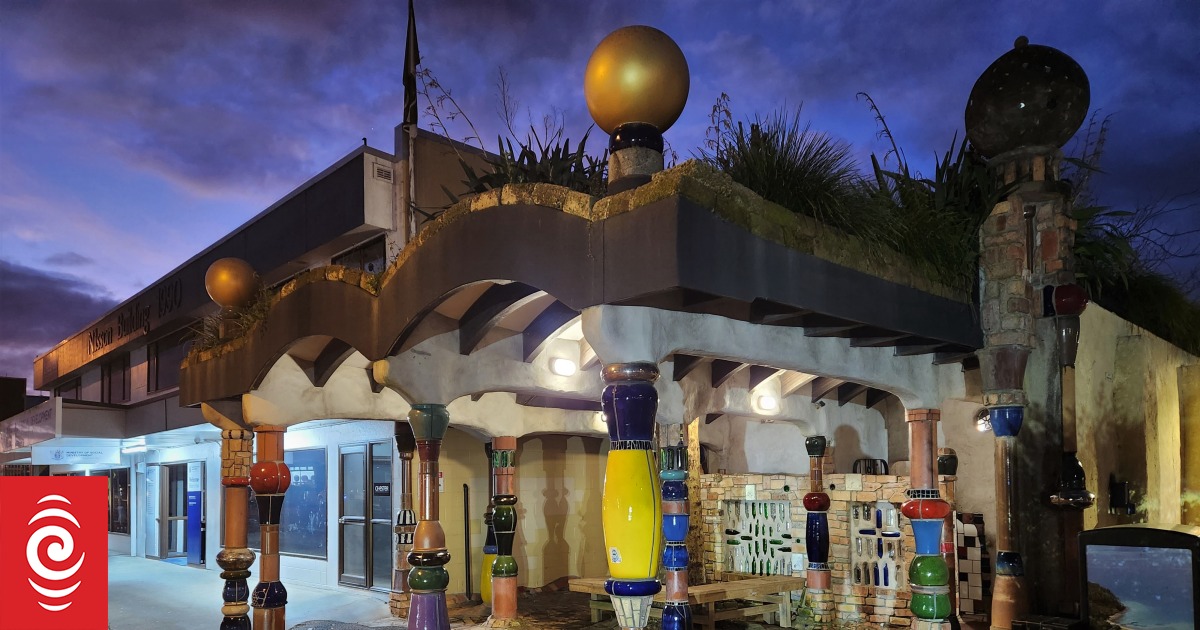
Kawakawa’s Hundertwasser toilets have been declared a Category 1 historic place.
Photo: RNZ / Peter de Graaf
A toilet block in a small Northland town is now officially one of New Zealand’s most significant buildings.
The Hundertwasser Toilets in Kawakawa have been declared a Category 1 historic place, ranking the loos alongside the likes of Christchurch Cathedral and Auckland’s War Memorial Museum.
Heritage New Zealand Pouhere Taonga Northland manager Bill Edwards said recognition for the quirky conveniences was well deserved.
“Although the Hundertwasser public toilet building in Kawakawa is less than 25 years old, its heritage values are remarkable,” Edwards said.
“The distinctive structure is unique and is the only public building in New Zealand that Hundertwasser was directly involved with.”
It had since become a Northland icon, attracting an estimated 250,000 visitors a year.
The Austrian-born Friedensreich Hundertwasser was an internationally-renowned architect with buildings in Europe, North America and Japan, Edwards said.
His transformation of Kawakawa’s prosaic 1960s public toilet block into a unique yet functional work of art was a reflection of his close relationship with the Bay of Islands community.
Edwards, who researched and wrote the heritage listing proposal, said the artist was born Friedrich Stowasser in Vienna to a Catholic father and a Jewish mother.
He joined the Hitler Youth during World War II to deceive the authorities and avoid persecution.
It was a dangerous strategy but it worked, Edwards said.
After the war he trained at the Academy of Fine Arts in Vienna and launched an artistic career that took him around the world.
He later changed his name to Friedensreich Regentag Dunklebunt Hundertwasser, though on the streets of Kawakawa he was simply known as Frederick.
A visit to New Zealand in 1973 for an exhibition at Auckland Art Gallery changed his life.
After the opening, Hundertwasser bought a Mini and travelled around the country meeting people, exploring, and swimming in the sea as often as he could.
“Frederick was smitten with what he saw. His first stay lasted 148 days and he was enthralled with the people and the country,” Edwards said.
“The following year he visited New Zealand twice, and on his second visit bought a 200 hectare property in the Kaurinui Valley near Kawakawa where he was to live and work until he died in 2000.”
Hundertwasser and his neighbours planted more than 150,000 trees in the valley to realise his vision of a “peace treaty” with nature.
His ideas were decades ahead of their time, Edwards said.

An estimated 250,000 people visit Kawakawa’s Hundertwasser toilets every year.
Photo: RNZ / Peter de Graaf
“Hundertwasser also believed that architecture should elevate and not subdue man, famously saying that he believed the straight line leads to the downfall of our civilisation. He also believed it’s good for people to walk on uneven floors and regain our human balance.
“Both aspects of his philosophy – harmony with nature and human-friendly architecture – strongly influenced the design of the Kawakawa public toilets.”
Another aspect of Hundertwasser’s philosophy was to modify rather than tear down modern buildings, improving them to reduce their environmental impact and beautify their appearance.
“Hundertwasser approached the concrete block public toilet building in Kawakawa as an architectural doctor curing the ailments of unsustainable, uniform structures. It’s fair to say Hundertwasser’s treatment for the building was radical surgery.”
He gave the toilets a living roof because, in his words, “the tree tenant pays rent in a more valuable currency than a human tenant”.
By that he meant the trees on the roof supplied oxygen, helped regulate climate, absorbed sound, “dispensed beauty”, and hosted birds and insects.
Other characteristics of Hundertwasser’s design style included bright colours and non-uniformity.
The toilet’s ceramic tiles were made by Bay of Islands College students while construction work was done by volunteers.
“What he and the wider community created is a building that brings joy.”
Noma Shepherd, Hundertwasser’s neighbour, read a message from the artist at the toilets’ opening in 1999: “Even small things can bring beauty into our life … it is harmony with beauty and harmony with nature, which makes us feel good. Beauty has an important function. Beauty is always underestimated.”
“That really sums up the philosophy and vision that inspired this exceptional take on what is the most humble of public facilities,” Edwards said.
“It is utterly unique – an authentic one-off from an artist who embraced the community at Kawakawa, and who was in turn embraced. We are proud to acknowledge this building’s special heritage attributes through this listing.”
Hundertwasser died shortly after the building was completed so did not see how it transformed the once-depressed town.
“By designing the public toilets to be so bright and colourful and people-friendly it encouraged travellers to stop, and when they stop of course they spend money and go to a café. When you go to Kawakawa now you can see the influence his architecture has had on the town with many other buildings on the main street given the ‘Hundertwasser treatment’.”
Other buildings around Northland have since followed Kawakawa’s famous public loos, some designed by the artist (such as Whangārei’s Hundertwasser Arts Centre) and others inspired by his philosophy (such as Kawakawa’s Te Hononga library and civic hub).
The Hundertwasser loos were not the only public toilets on the Heritage List.
Other notable entries include the Taj Mahal public toilets in central Wellington, the Edwardian bus shelter and toilets next to Auckland’s Grafton Bridge, and the World War I memorial women’s restroom in Napier.




